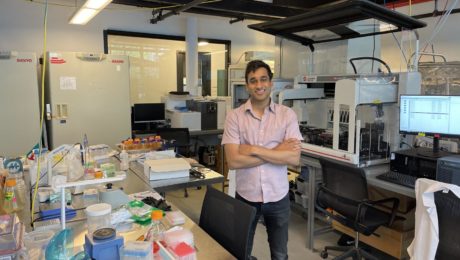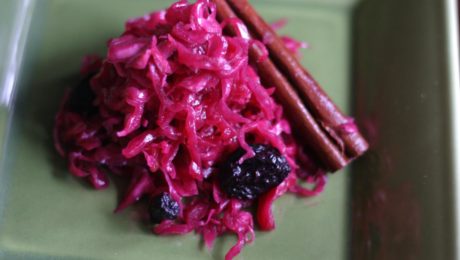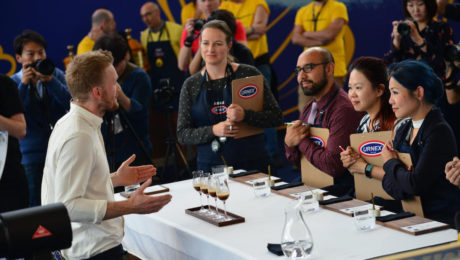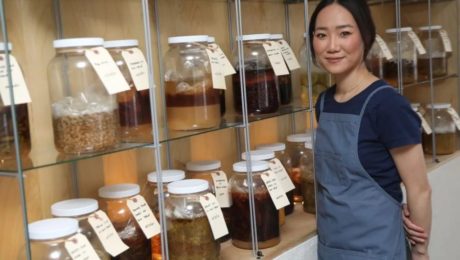Microbial Farmers
An article in Modern Farmer highlights “the new generation of microbial farmers,” scientists using microbes to replace chemical additives in food.
At Kingdom Supercultures, co-founders Ravi Sheth (pictured) and Kendall Dabaghi have developed natural microbial strains that mimic additives “instead of having a library of artificial chemicals.” Scientists at the company use machine learning to explore millions of “uncharacterized microbes that live inside fermented food. They extract microbial strains, merge them with other isolates and design what they call ‘supercultures.’”
The end results are healthier compounds with flavors, textures and functional properties similar to their artificial – and less healthy – counterparts. Since the company launched in 2020, they’ve made additives for plant-based cheese and yogurt, vegan personal care products and a vegan butter exclusive to Eleven Madison Park restaurant in New York.
Read more (Modern Farmer)
- Published in Business
Jewish Delis GoVegan
Jewish delis are evolving for modern consumers, offering plant-based alternatives to lox and pastrami.
“We’re literally saving the Jewish deli. We’re giving it the modern twist that’s desperately needed to stay delicious and relevant to a growing segment of the population,” said Jenny Goldfarb, the founder and CEO of Unreal Deli. Goldfarb’s plant-based corned-beef-pastrami hybrid attracted an investment deal on SharkTank, and today it’s available in 2,200 grocery stores.
Though Jewish cuisine is known for being heavy on meat, vegetarian food has a part in Ashkenazi culture, notes Jeremy Umansky, chef at Larder Deli in Cleveland. He points out that kashruth (kosher dietary laws) and periods of poverty meant Jewish cuisine always included vegetarian recipes.
The food at Larder — which includes vegan and vegetarian dishes — is put through the same process as animal-based items. Umansky cures mushrooms with salt and koji for a smoky, savory flavor and meat-like texture.
“It’s all about the method and technique behind the production of those foods,” Umansky said. “You know, going back and looking at things and seeing that there is historical precedent for this.” Pictured, a selection of vegan Jewish deli fare at Ben & Esther’s in Portland, Oregon.
Read more (Insider)
- Published in Business, Food & Flavor
Noma’s First Consumer Product Sells Out
Noma launched their direct-to-consumer food products line in February with a smoked mushroom garum. Their vegan spin on a traditional fermented fish sauce is the first release from Noma Projects, the famed restaurant’s product line for home cooks. That garum, retailing for $24 per 250cl bottle, sold out in a day.
“At Noma they’ve turned to koji and mushrooms instead of fermented fish to create their umami-rich smoked mushroom garum. It’s not as intensely salty as some other garum-adjacent products, and the aroma and flavor reveal subtle smoke and mushrooms,” writes Florence Fabricant of The New York Times.
Noma Projects — which launched last year — will include more pantry projects and community-based initiatives in the future, said René Redzepi, chef and co-owner of the Copenhagen-based restaurant. He hopes Noma Projects will him make more money. Noma has hovered around a slim 3% profit margin ever since opening 18 years ago.
Read more (The New York Times)
- Published in Business, Food & Flavor
Expo West Returns
In March 2020, Natural Products Expo West became one of the first casualties in the U.S. events world, shut down by the outbreak of Covid-19 even as booths were being set up in Anaheim. Now, two years later, Expo West returns to Orange County with natural food exhibitors from around the world. TFA staff and advisory board members will also be in attendance.
In 2019, the enormous spring trade show attracted around 88,000 registrations; this year, that number is estimated at 55,000-60,000. Show producer New Hope Network (part of London-based Informa PLC) is also including a virtual option for attendees still unable or unwilling to travel.
The trends at this year’s event are being driven by Millennial and Gen Z consumers. New Hope put a spotlight on six top themes in a recent webinar:
No. 1: Functional Ingredients. “Health and wellness products make up a quarter of the volume of the industry but represent two-thirds of all growth,” said SPINS Data Analyst Scott Dicker. “We’re seeing consumers pushing for individual pursuit of wellness across channels.”
No. 2: Organic & Regenerative. Food that focuses on performance nutrition, food made with ashwagandha or food with paleo ingredients are driving growth for organic and regenerative products. Sodas and carbonated beverages are also helping organic products grow, “one of the last ‘junk food’ categories penetrated by natural and organic,” Dicker said. Gut health sodas, especially.
No. 3: Climate and Sustainability. Media headlines are declaring carbon as the new calorie. Consumer surveys speak to that — 70% will pay more for “premium, sustainable, climate-friendly products” and 80% want brands to educate them on their roles in climate issues. Companies are changing ingredient sources and product packaging to be more environmentally-friendly.
No. 4: Diversity. “Over the past couple years, we’ve seen tremendous growth in women, minority, NGLCC (National LGBT Chamber of Commerce) certified and veteran-owned businesses and you’re going to see it all over the show floor,” Dicker said.
No. 5: Plant-Based Innovation. Plant-based eating has skyrocketed over the last five years. “But plant-based alone isn’t enough anymore. What are plant-based brands doing to keep up with innovation?” Dicker said.
No. 6: Sustainable Meat & Dairy. Though the sustainable meat and dairy category is down 2.1%, pockets of it are growing, specifically grass-fed, fair trade and animal welfare and sustainability claims. Innovations are coming from small and local farms.
Read more (New Hope Network)
- Published in Business, Food & Flavor
KojiCon Highlights
Over 1,100 koji experts and enthusiasts from 63 different countries and 49 states gathered virtually for this year’s KojiCon. Koji, the mold-based ferment prevalent in East Asia and used to make soy sauce, sake and miso, is becoming more common in restaurants and in home cooking around the world.
The second annual KojiCon wrapped-up March 6. It was created by the Yellow Farmhouse Education Center, a nonprofit organization based at Stone Acres Farm in Stonington, Connecticut. The center focuses on food and farm education through educational opportunities. Rich Shih, co-author of Koji Alchemy, who helps organize the event, joined speakers like Sandor Katz, Misti Norris, Takashi Sato, Hiroko Shimbo, Kirsten Shockey, Jeremy Umansky and David Zilber and Mara King speaking on the theme of “Changing Food for Good.”
“It opens our eyes to possibilities beyond koji, within the Asian approach towards fermentation, primarily mold-based,” Shih said of the conference. “We want you to discover that, through fermentation, maybe just adding a little bit of salt or drying it or you know of course adding these mold-based ferments that we’re talking about, you can create amazing flavors.”
Pictured are Jen Rothman and Eric Dawson of Yellow Farmhouse, Shih, Irene Yoo of Yoo Eating, King and Umansky.
Though the conference is over, tickets to watch the recordings are still available at: https://kojicon.org/
- Published in Food & Flavor
Asian American Entrepreneurs React to Online Trolls
Racist and sexist comments have long been hurled at food companies run by Asian American women. But in the modern tech era, where food brands have a social media presence, these cruel remarks from trolls are being dealt with in a variety of ways. Some fight back with humor, others aim to educate while some ignore it.
Kim Pham, co-founder (with her sister Vanessa) of Omsom (which sells Asian pantry staples), said it was difficult in the brand’s early days for her to read offensive comments. She came to a sad realization: “I think it’s par for the course when you are an outspoken brand run by women of color.”
“For so long our community has been defined by this model minority myth, of being quiet, or docile, or submissive,” said Pham, “and we really just wanted to give a middle finger to that.”
Omsom’s social media policy is to remove insulting comments, but leave anything that “might generate a fruitful conversation.”
Jing Gao of Fly By Jing (which sells Asian pantry staples, dumplings and hot pots) (pictured), though, takes a different approach. “We have no problem making fun of those people who are, you know, clearly disturbed,” said Jing Gao, the company’s 34-year-old founder, adding “We definitely troll them. … and our community seems to really love it.”
Meanwhile Sahra Nguyen, founder of Nguyen Coffee Supply, has zero tolerance for trolls. She doesn’t want her employees engaging in toxic behavior, so they don’t respond.
Read more (The New York Times)
- Published in Business
“Bacterial Bully” Could Create Healthier & Tastier Fermented Foods
Microbiologists have long considered that there are two distinct categories of energy conservation in microorganisms: fermentation and respiration. Lactic acid bacteria (LAB) use fermentation, making it central to food and drink production and preservation since the dawn of man.
But researchers at the University of California, Davis, and Rice University discovered a LAB species that uses a hybrid metabolism, combining both fermentation and respiration.
“These are two very different things, to the extent that we classify bacteria as basically one or the other,” said Caroline Ajo-Franklin, a bioscientist at Rice University and co-author of the study. “There are examples of bacteria that can do both, but that’s like saying I can ride a bicycle or I can drive a car. You never do both at the same time.”
“What we discovered is a LAB that blends the two, like an organism that’s not warm- or cold-blooded but has features of both,” she said. “That’s the big surprise, because we didn’t know it was possible for an organism to blend these two distinct metabolisms.”
The species — lactiplantibacillus plantarum — is what scientists call a bacterial bully because it takes advantage of two distinct metabolic processes, according to a press release from Rice on the study. These systems were “not previously known to coexist to acquire the fuel they burn for energy.”
“Using this blended metabolism, lactic acid bacteria like L. plantarum grow better and do a faster job acidifying its environment,” said Maria Marco, a professor in the food science and technology department at UC Davis and the study’s co-author [and a TFA Science Advisor].
The discovery is significant for food and chemical production. New technologies that use LAB could now produce healthier and tastier ferments, minimize food waste and change the flavors and textures of fermented food.
“We may also find that this blended metabolism has benefits in other habitats, such as the digestive tract,” Marco said. “The ability to manipulate it could improve gut health.”
The study began with a puzzle: the realization that genes responsible for the electron transfer pathway in mainly respiratory organisms also appear in the LAB genome. “It was like finding the metabolic genes for a snake in a whale,” Ajo-Franklin said. “It didn’t make a lot of sense, and we thought, ‘We’ve got to figure this out.’”
While the Davis lab studied the genome, the team at Rice carried out fermentation experiments on kale.
“It wasn’t our first choice,” said Rice alumna and co-lead author Sara Tejedor-Sanz (now a senior scientific engineer in the Advanced Biofuels and Bioproducts Process Development Unit at Lawrence Berkeley National Lab).
“We performed some initial experiments with cabbage, since that’s a known fermented food — sauerkraut and kimchi — in which lactic acid bacteria are present,” she said. “But there were technical difficulties and it didn’t turn out so well. So we looked for another food to ferment where LAB could be found in its ecological niches.
“Kale has compounds like vitamins and quinones that lactic acid bacteria use as cofactors in their metabolism, and are also involved in interacting with the electrodes,” she said. “We also found fermenting kale to make juice was a trend. It sounded perfect for our biochemical reactors.”
The study showed LAB enhances metabolism through a FLavin-based Extracellular Electron Transfer (FLEET) pathway that expresses two genes (ndh-2 and pp1A) associated with iron reduction, a step in the process of stripping and incorporating electrons into ATP (adenosine triphosphate (ATP), energy-carrying molecule).
Because LAB’s genome has evolved to be small, thus requiring less energy to maintain, the wide conservation of FLEET must serve a purpose, Ajo-Franklin said.
“Our hypothesis is this helps bacteria get established in new environments,” she said. “It’s a way to kick-start their metabolisms and outcompete their neighbors by changing the environment to be more acidic. It’s being a bully.”
That the FLEET pathway can be triggered with electrodes offers many possibilities, she said. “We found we can use the hybrid metabolism in food fermentation,” Ajo-Franklin said. “Now we have a way to change how food may taste and avoid failed food fermentations by using electronics.”
“We may also find that this blended metabolism has benefits in other habitats, such as the digestive tract,” Marco said. “The ability to manipulate it could improve gut health.”
Ajo-Franklin noted LAB are commonly found in the microbiomes of many organisms, including humans. “You can already buy it in health food stores as a probiotic,” she said. “The human gut is an anaerobic environment, so LAB have to keep a redox balance. If it oxidizes carbon to gain energy, it has to figure out a way to reduce carbon somewhere else.
“Now we think if we provide another electron donor or acceptor, we could promote the growth of positive bacteria over negative bacteria.”
UC Davis graduate student Eric Stevens is co-lead author of the study. Co-authors are Rice graduate student Siliang Li; at UC Davis, graduate students Peter Finnegan and James Nelson, and Andre Knoesen, a professor of electrical and computer engineering, at UC Davis; and Samuel Light, the Neubauer Family Assistant Professor of Microbiology at the University of Chicago.
Ajo-Franklin is a professor of biosciences and a CPRIT Scholar. Marco is a professor of food science and technology.
The National Science Foundation, Office of Naval Research, the Department of Energy Office of Basic Energy Sciences and a Rodgers University fellowship supported the research.
The study results were published in the journal eLife.
- Published in Food & Flavor, Health, Science
Changing Face of Specialty Coffee
Gesha (or Geisha) coffee has been the favored variety in coffee competitions for over 15 years. But recently specialty coffee brewers are using a new variety: the species C. eugenioides. An article in Perfect Daily Grind details the shift.
As Gesha became the preferred choice of coffee champions (seven of the World Brewers Cup (WBrC) champions from 2011 to 2019 used Gesha), the price started to rise. Gesha production, common in Panama, began to increase in other countries wanting to farm the popular variety, notably Colombia and Ethiopia. But increased production led to some lower-quality Geshas coming to market.
In recent years, producers have opted for lesser-known coffees, notably eugenioides, a species of arabica originating in East Africa. Its flavor profile is unique, with notes of tropical fruit, and has lower levels of caffeine. But it can be a risky variety. Eugenioides trees are small and produce small cherries, and they take years to grow.
A possibly more sustainable option for the industry: innovative processing techniques. The 2015 WBrC winner won using carbonic maceration process, a fermentation technique used in the wine industry.
“Fermentation is an effective way to influence the aroma and taste of coffee. It changes the acidity levels and body of coffee,” explains Chad Wang, founder of VWI by Chad Wang, a specialty coffee judge and the 2017 WBrC winner. “Fermentation can significantly help coffee farms to offer different tastes without having to change too much.”
[To learn more about fermentation in coffee, check out TFA’s webinar with the Specialty Coffee Association “The State of the Art in Coffee Fermentation.” The two organizations will be partnering again for a Spanish language version of the free webinar on March 3.]Read more (Perfect Daily Grind)
- Published in Food & Flavor
Canada’s Culinary Trailblazer
Briana Kim is making a name for herself in the Canadian food scene, “putting Ottawa on the map with a focus on fermentation,” writes the Ottawa Citizen. Kim, a self-taught, award-winning chef, runs Alice, a vegan restaurant in Ottawa’s Little Italy neighborhood. Her specialty is fermentation-applied, plant-based cooking. Last fall, she was invited to Eleven Madison Park in New York to share her insight with the chefs as they transitioned to a vegetarian-oriented restaurant.
Continues the article: “It’s definitely a rarefied subject. But in the world’s top-tier kitchens, fermenting food is a red-hot trend, with plant-based cooking not far behind. At Alice, Kim’s imaginative creations such as charcoal-grilled dried maitake mushrooms and sunchokes served with a salsa of tomato and fermented green strawberries, and a sweet pea miso dipping sauce make clear that Alice’s name’s alludes to a surprising culinary wonderland.”
Alice, which opened in 2019, operates with a culinary and scientific focus.
“The innovation and the R&D have to be the No. 1 focus for us,” Kim says. “Fermentation allows us to discover how different food molecules break down and change in texture and flavors, and we are always searching for flavors we haven’t tasted before.”
The waiting room at Alice is filled with jars of Kim’s different ferments, many of which she sells under her Mad Ferments label. She utilizes locally-grown ingredients, planning the menu at Alice months in advance.. For example, she serves cauliflower, spring greens and melons in the middle of winter by fermenting them in the summer.
“Fermentation has existed for such a long time, but I think we are putting our twist on it,” Kim says.
Read more (Ottawa Citizen)
- Published in Food & Flavor
Analyzing the World’s Fermented Beverages
Can indigenous fermented beverages play a prominent role in a healthy diet? Biochemists studied four commercial products – kefir and ryazhenka from Russia, amasi and mahewu from South Africa. Their research was published in the journal Foods.
Researchers from the Institute of the Research Center of Biotechnology of the Russian Academy of Science (RAS) and South Africa’s Durban University of Technology discovered key elements of the fermented drinks. The three that are milk-based had more antioxidants than the corn-based one, while the corn drink (mahewu) was “better at suppressing the angiotensin-converting enzyme.” Kefir and ryazhenka, meanwhile, have a more diverse composition of fatty acids.
“Usually, food is considered only as a source for sustenance. However, more and more people (are starting) to believe that it also should preserve and improve health,” Konstantin Moiseenko, co-author of the study and a research fellow at RAS in Moscow. He notes modern science allows “mankind to look differently at the usefulness of traditional, centuries-old foods. Our research focuses on fermented products, which regular consumption can potentially prevent atherosclerosis, hypertension and thrombosis.”
Read more (Lab Manager and Foods)









